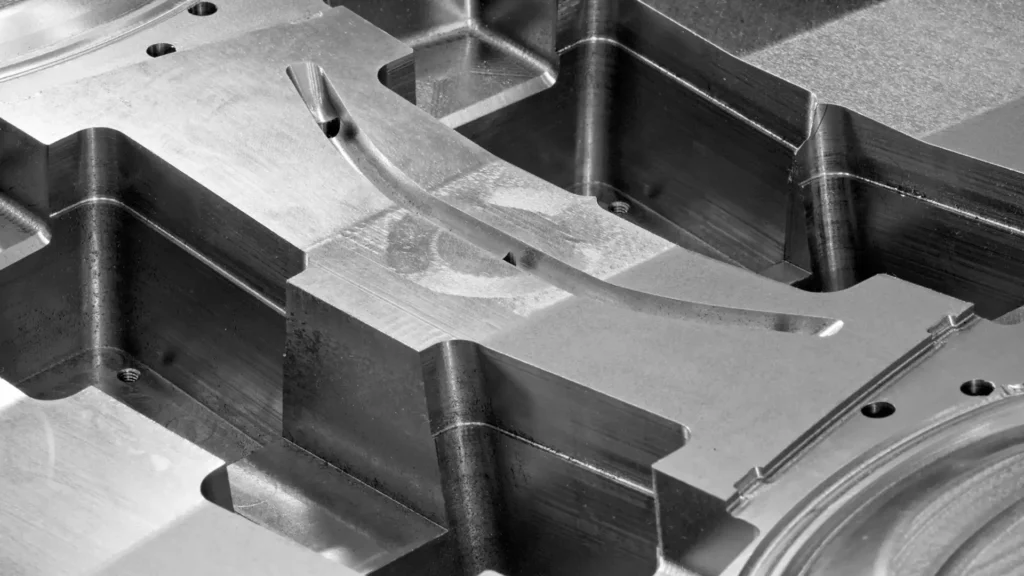製造と製造の世界, CNCルーティングは、複雑で正確なデザインの作成方法に革命をもたらしました. 高度な技術の助けを借りて, CNCルーティングマシンは、比類のない精度と効率を持つ幅広い材料をカットして形作ることができます. この記事では, CNCルーティングの内外を探索します, その基本原則から、さまざまな業界でのアプリケーションまで.
CNCルーティングとは何ですか?

CNCルーティングは、コンピューター数値制御ルーティングを表します, これは、事前にプログラムされたデザインに従って材料をカットおよび形成するためにコンピューター制御マシンを使用するプロセスを指します. このテクノロジーは、正確で一貫した結果を可能にします, 複雑な部品やコンポーネントの製造に最適です.
CNCルーターマシンとは何ですか
CNCルーターマシンは、木材などの材料を切断して形成するために特別に設計されたCNCルーティングマシンの一種です, 金属, プラスチック, および複合材料. これらのマシンは、所定の形状または設計を作成するために所定のパスに沿ってツールを導くコンピューター制御システムに接続された切削工具で構成されています.
CNCマシンの仕組み?
CNCマシンは、デジタル設計ファイルを解釈し、その情報を使用して切削工具の動きを制御することで機能します. オペレーターは、設計パラメーターをコンピューターシステムに入力します, 次に、指示を切削工具の正確な動きに変換します. このレベルの自動化により、製造プロセスの精度と効率を向上させることができます.
CNCルーティングの段階的なプロセス
- デザインの入力: CNCマシンの操作の最初のステップには、設計パラメーターをコンピューターシステムに入力することが含まれます. このデジタルデザインファイルは、切断および形成プロセスの青写真として機能します.
- 指示の解釈: 設計ファイルがアップロードされたら, コンピューターシステムは、指示を解釈し、それらを切削工具の正確な動きに変換します. この翻訳により、最終製品が設計仕様と一致することが保証されます.
- ツールを導きます: CNCマシンは、設計ファイルに概説されている所定のパスに沿って切削工具を導きます. ツールはxに沿って移動します, y, およびz軸, 目的の形状またはパターンを作成するためのプログラムされた指示に従ってください.
- 切断プロセスの実行: 切削工具が材料を横切って移動するにつれて, 一連の正確な動きで余分な材料を除去します. この切断プロセスは、最終的な形状またはデザインが達成されるまで繰り返されます, その結果、設計の正確な要件を満たす完成品が生まれます.
- 操作の監視: 切断プロセス全体, CNCマシンは、一貫性と精度を確保するために、切断パラメーターを継続的に監視および調整します. このリアルタイムフィードバックメカニズムは、切断操作を最適化し、品質管理を維持するのに役立ちます.
- タスクを完了します: 切断プロセスが完了したら, CNCマシンは操作を停止します, 完成品は、さらに処理または組み立てられる準備ができています. CNCマシンの効率と精度により、製造業で不可欠なツールになります.
CNCルーティングマシンの種類
利用可能なCNCルーティングマシンにはいくつかの種類があります, それぞれに独自の機能とアプリケーションがあります.
あ. 3-軸機
3軸CNCルーティングマシンから始めます, これらのシステムには、切削工具を3つの主要な軸に沿って移動する機能が装備されています。, y, およびz. この基本的な構成により、基本的な切断と形成操作が可能になります, それらを汎用性があり、幅広いアプリケーションに適しています. 3-軸機は、プロファイリングなどのタスクに一般的に使用されます, 彫刻, さまざまな材料を彫ります.
B. 4-軸機
4軸CNCルーティングマシンに移動します, これらのシステムは、追加の回転軸をミックスに組み込むことでさらに一歩進んでいます. 3つの主軸に加えて, 4-軸機は、4番目の軸に沿って切削工具を回転させることができます, より複雑なデザインと形状を作成するための強化された機能を提供する. 湾曲した表面と複雑な輪郭の周りを操縦する能力を備えています, 4-軸機は、より高いレベルの精度と詳細を必要とするアプリケーションに適しています.
C. 5-軸機
CNCルーティングテクノロジーの最前線には5軸機があります, 比類のない精度と汎用性で有名です. 標準の3つの軸に加えて, 5-軸マシンは、2つの追加の軸に沿って切削工具を傾けて回転させる機能を誇っています. この高度なレベルの操縦性により、非常に複雑で詳細なデザインを簡単に生産できます. 5-軸機は航空宇宙などの産業でよく使用されます, 自動車, そしてプロトタイピング, 複雑な形状と滑らかな輪郭が不可欠です.
CNCルーティングの利点と短所
CNCルーティングの利点
- 精度: CNCルーティングマシンは、例外的な精度を提供します, 製品が設計仕様と正確に一致するようにします. これは、厳しい許容範囲と複雑な詳細を必要とする業界では非常に重要です.
- 効率: CNCルーティングは、生産プロセスを合理化します, 自動化による時間と人件費の削減. 高品質の出力を維持しながら生産性を高めます.
- 多用途性: 汎用性の高いCNCルーターは、木材などのさまざまな材料を処理できます, 金属, プラスチック, および複合材料, 幅広い産業やアプリケーションに対応しています.
- カスタマイズ: CNCルーティングにより、カットカットパスをプログラミングすることにより、カスタマイズされた複雑なデザインを簡単に作成できます. この柔軟性は、特定の設計要件を効率的に満たしています.
- 一貫性: CNCルーターは、生産の実行全体で一貫した品質を提供します, 均一性を確保し、自動車やエレクトロニクスなどの業界で高い基準を満たす.
- 費用対効果: 初期投資にもかかわらず, CNCルーティングは、廃棄物の減少により長期コスト削減を提供します, 効率の向上, 市場の需要に適応するためのスケーラビリティ.
CNCルーティングの短所
- 複雑: 運用とプログラミングCNCルーティングマシンには、特別なスキルとトレーニングが必要です, これは、必要な専門知識なしに一部のビジネスにとって障壁になる可能性があります.
- 料金: CNCルーティング機器への初期投資は重要な場合があります, 中小企業や予算が限られている人にとって大きな財政的コミットメントになる.
- メンテナンス: CNCルーティングマシンは、最適なパフォーマンスを確保するために、定期的なメンテナンスと維持を必要とします, 全体的な運用コストとダウンタイムに追加できます.
- 限られた柔軟性: CNCルーティングマシンは、材料切断に汎用性を提供します, 彼らは、彼らが扱えるワークのサイズと形状の点で制限があるかもしれません, いくつかの設計の可能性を制限します.
CNCルーターでどの材料をカットできますか?
CNCルーターは、幅広い材料をカットできます, 木材を含む, 金属, プラスチック, アクリル, および複合材料. この汎用性により、さまざまな業界に最適です, 木工から航空宇宙へ.
- 森: CNCルーターは、さまざまな木材の種類の切断に優れています, オークのような広葉樹を含む, メープル, そしてクルミ, 松や杉などの柔らかい森と同様に.
- プラスチック: CNCルーターは、さまざまな種類のプラスチックを切断することにも熟達しています, アクリルなど, PVC, ポリカーボネート, とナイロン.
- 金属: すべてのCNCルーターが金属を切断するように設計されているわけではありませんが, 必要なツールと機能を備えた一部のモデルは、アルミニウムを処理できます, 真鍮, 銅, その他のソフトメタル.
- 複合材料: CNCルーターは、グラスファイバーなどの複合材料の切断に一般的に使用されます, 炭素繊維, およびラミネート
- フォームとフォームのような材料: CNCルーターは、フォームとフォームのような材料をカットすることもできます, 拡大したポリスチレンなど (EPS) ポリウレタンフォーム.
CNCルーティングのアプリケーション
CNCルーターの汎用性と効率により、幅広いアプリケーションに不可欠なツールになります, メーカーが複雑な設計を実現できるようにします, 生産プロセスを合理化します, 製品の品質を向上させます.
木工
CNCルーティングテクノロジーは、木工業界の礎石としての地位を確立しています, 複雑なデザインを作成するために必要なツールと機能を木工に提供する, 複雑な形状をカットします, カスタム家具とキャビネットを生産します. 装飾的なミルワークの作成から、オーダーメイドの家具の設計まで, CNCルーターは、木工の職人技を新たな創造性と精度に向上させる精密な切断と形成機能を提供します.
金属製造
金属製造の領域で, CNCルーティングテクノロジーは、並外れた精度と精度で金属部品の生産において極めて重要な役割を果たします. CNCルーターを利用します, 金属製造業者は、金属成分を切断して形作ることができます, で使用されるものを含む アルミダイカスト, 細心の詳細と一貫性を備えています. 複雑な設計と正確なカットを作成する機能により、CNCは多様な産業向けの製造コンポーネントのための不可欠なツールをルーティングします, 自動車や航空宇宙から電子機器や機械まで.
プラスチック製造
同様に, CNCルーティングテクノロジーは、プラスチック製造業界で広範なアプリケーションを見つけます, プラスチック部品をカットして形作るために利用されている場所, カビ, 比類のない精度と再現性を備えたプロトタイプ. カスタムサイネージとディスプレイの作成から、さまざまな製品用の複雑なプラスチックコンポーネントの生産まで, CNCルーターは、プラスチック製造業者が高品質の結果を効率的かつコスト効率的に達成できるようにします. さまざまな種類のプラスチックを処理する際のCNCルーティングの汎用性は、プラスチック製造セクターの多様なニーズを満たすための多用途のソリューションになります.
Bian Die Castと協力しています
あなたが探しているなら ワンストップアルミニウムダイキャスティングメーカー それはダイキャスティングを提供します, CNC加工, 仕上げサービス, ビアン・ダイ・キャストよりももう探す必要はありません. 業界の長年の経験と専門知識があります, Bian Die Castは、高品質の製品と例外的なカスタマーサービスの提供に取り組んでいます.
結論
結論は, CNCルーティングは、比類のない精度を提供することで製造業を変えた強力な技術です, 効率, そして多用途性. あなたが木工をしているかどうか, 金属製造, またはプラスチック製造, CNCルーティングマシンは、複雑な部品とコンポーネントを簡単に生産するための費用対効果の高いソリューションを提供します. Bian Die Castのような信頼できるメーカーと提携することは、プロジェクトを次のレベルに引き上げ、製造業で成功を収めるのに役立ちます.

















